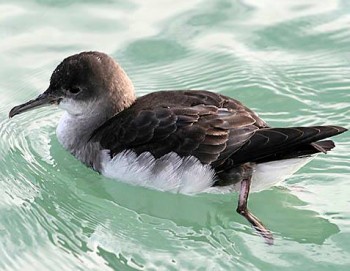Della Bennet (School of Biological Sciences, University of Canterbury, Christchurch, New Zealand) and colleagues have published open access in the journal Ecology and Evolution on at-sea movements of the globally Endangered and Endemic and Nationally Vulnerable Hutton's Shearwater Puffinus huttoni.
The paper’s abstract follows:
“The Hutton's shearwater Puffinus huttoni is an endangered seabird endemic to Kaikōura, New Zealand, but the spatial and temporal aspects of its at‐sea foraging behavior are not well known.
To identify foraging areas and estimate trip durations, we deployed Global Positioning Systems (GPS) devices and Time‐Depth Recorders (TDR) on 26 adult Hutton's shearwaters during the chick‐rearing period in 2017 and 2018.
We found Hutton's shearwaters traveled much further from their breeding grounds at Kaikōura than previously considered, with most individuals foraging in coastal and oceanic areas 125–365 km south and near Banks Peninsula. Trip durations varied from 1 to 15 days (mean = 5 days), and total track lengths varied from 264 to 2,157 km (mean = 1092.9 km).
Although some diving occurred in near‐shore waters near the breeding colony, most foraging was concentrated in four regions south of Kaikōura. Dive durations averaged 23.2 s (range 8.1 to 71.3 s) and dive depths averaged 7.1 m (range 1.5 to 30 m). Foraging locations had higher chlorophyll a levels and shallower water depths than nonforaging locations. Birds did not feed at night, but tended to raft in areas with deeper water than foraging locations.
Mapping the spatial and temporal distribution of Hutton's shearwaters at sea will be fundamental to their conservation, as it can reveal potential areas of overlap with fisheries and other industrial users of the marine environment.”

Hutton's Shearwater at sea
Reference:
Bennet, D.G., Horton, T.W., Goldstien, S.J., Rowe, L. & Briskie, J.V. 2019. Flying south: foraging locations of the Hutton's shearwater (Puffinus huttoni) revealed by Time‐Depth Recorders and GPS tracking. Ecology and Evolution doi.org/10.1002/ece3.5171.
John Cooper, ACAP Information Officer, 25 July 2019

 English
English  Français
Français  Español
Español